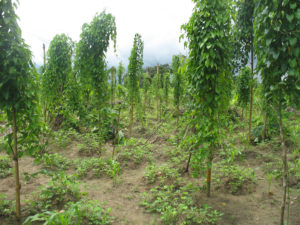
Science Advances—Yams as seen today in West Africa descended from a forest species, a new study finds. The results challenge the hypothesis that domestication of sub-Saharan African plants mostly arose in tropical savannahs. Critically, they also advance researchers’ understanding of West African crops’ domestication history, helping to identify a major cradle of domestication around the Niger River. One of the best-known domestication cradles in the world is the Fertile Crescent in the Middle East, where wheat, barley, oat, lentil and chickpea, among other crops, first appeared in the archaeological records. The history of crop domestication is much less documented in sub-Saharan Africa, in part because archaeological studies are largely fragmentary. Previous studies of domestication in Africa suggest an origin encompassing a large area from Senegal to Somalia, while more recent studies have challenged this hypothesis – proposing a more restricted domestication origin near the Niger River Basin. To assess whether areas near the Niger Basin could be considered major hotspots of domestication, Nora Scarcelli and colleagues investigated the domestication of yam, a major staple crop originating from Africa. They used genome re-sequencing to analyze 167 “wild” and domesticated yam species from the country. Their analysis, which included sophisticated statistical modeling, suggests that that cultivated yam was domesticated from a forest species, D. praehensilis, starting in the Niger River basin. Its domestication process involved adaptations to the open field environment and human selection that increased tuber size and starch content in the cultivated yam. The study further suggests that the Niger River region played a major role in African agriculture, comparable to the Fertile Crescent in the Near East.
_____________________________

Field of cultivated yam in the south-east of Cameroon. IRD, Roland Akakpo
_____________________________
Article Source: A Science Advances news release





